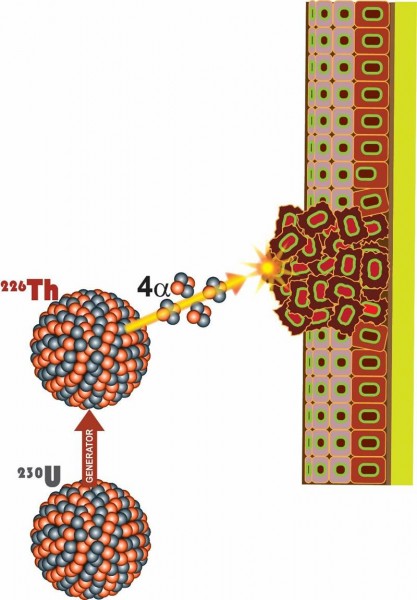Los Alamos Develops Generator for Uranium-230/Thorium-226 Radioisotope

A new system developed at Los Alamos National Laboratory for producing alpha-emitting medical radioisotopes targets and overpowers diseased tissue while sparing the healthy tissue around it. The generator holds uranium-230, which decays to thorium-226. Further decay produces short-lived daughter isotopes, emitting four more alpha particles resulting in a very high combined radiation dose to destroy cancer cells.
“The new system is based on a uranium-230/thorium-226 pairing, where the thorium-226 is supplied in a form suitable for medical applications,” said Michael Fassbender, the lead researcher at Los Alamos. “The thorium-226 emits multiple alpha particles as it decays, delivering a powerful blow to diseased cells. This is similar to actinium-225, another promising alpha therapy isotope. The DOE Isotope Program is committed to making multiple options, or a variety of radioisotopes available to accelerate the development of therapeutics that could be used to treat different cancers.”
Through a chemical process, the new Los Alamos generator allows repeated separation of thorium-226 from its parent, uranium-230. The generator will be available to a researcher through the National Isotope Development Center (NIDC), giving them a consistent supply of thorium-226 to use in investigating the next steps in creating the radiopharmaceuticals needed to treat patients.
Radioisotopes are a key weapon in the medical arsenal for treating cancer. Most treatments use beta-particle-emitting isotopes to destroy cancer cells. Alpha particles can do a better job. Not only do they carry much more destructive energy, but they also release this energy over a very short range, which allows for large radiation doses to be transported in microscopic volumes directly to the malignant cells. Thus, healthy tissue is less likely to be damaged. Alpha particle therapeutics are also effective against cancer that has metastasized and spread around the body.
The research is supported by the U.S. Department of Energy Isotope Program, managed by the Office of Science.